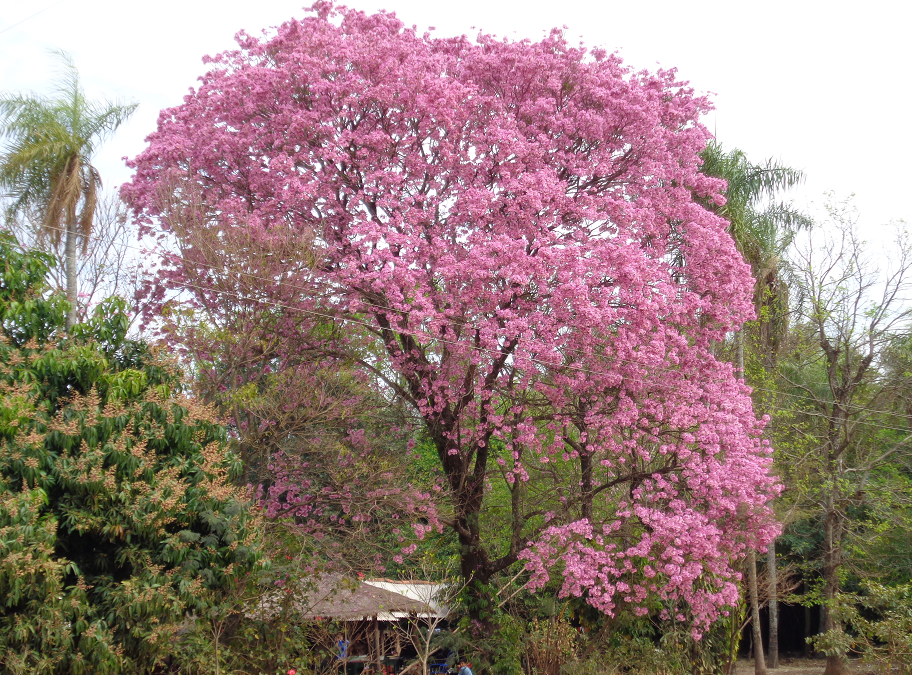The lapacho is the national tree of Paraguay. It is a common sight across the country. When in bloom it is a very distinctive and easily spotted tree.
In Guarani the lapacho is known as tajy and has varieties with various colours of flowers. They are all however closely related members of the genus handroanthus. By far the most common is the pink flowering handroanthus impetiginosus. In addition to this there are varieties that cloak themselves with flowers of white, yellow or purple.
Lapacho trees grow wild across Paraguay as they do across much of South America. Their straight trunks and colourful flowers also have made them popular as ornamental trees. They are often planted in parks or along tree lined boulevards. A number planted together has a dramatic appearance when in bloom.
Their flowers last for a number of months through the middle part of the year. Lapachos in full bloom are to be seen across Paraguay from July to September. They do though take many years to reach sufficient maturity to produce flowers. I have one grown from a sapling more than ten years ago which is still to produce a single flower.
The wood of the lapacho is a very dense hardwood. In appearance it ranges from olive brown to black. It is resistant to rot and other forms of decay an suitable for use outdoors as garden furniture or decking. Additionally its fine grain and patterns make the wood ideally suited for use as roofing beams where the timbers are to be left visible. It is used sparingly however as it is an expensive wood.
The trees themselves grow to heights of between 15 and 30 metres. The trunk itself is straight supporting a canopy of branches. These drop their leaves as winter approaches and produce first flowers and then afterwards the next years leaves.
The leaves of the lapacho are relatively small. They are oval in shape with serrated edges. Generally five will grow together on a single stem.
In the wild the trees do not grow together in clumps. Rather they are spread thinly throughout the forest. This can result is deforestation when trees are harvested in the wild. Large areas may be cleared in a forest in search of a few more valuable tree specimens.
However if deliberately planted a lapacho is not a difficult tree to grow. This in addition to the annual display of flowers is what makes it such a desirable ornamental tree. This ease of growth has lead to the lapacho being imported as an ornamental trees in many other countries across the world with suitably warm climates.
As part of the traditional heritage of Paraguay it stands to reason that the tree is used for more than just decorative purposes. It is part of the traditional herbal medicines of Paraguay. The inner bark for example is used to make lapacho tree. This is believed to be a cure for such ailments as fever and stomach complaints.
The lapacho tree is as such an important symbol for Paraguay. Its flowers brighten parks and forests for many months of the year and it is commonly depicted on Paraguayan works of art. Further to its visual beauty it also forms a part of the natural medicine cabinet. For that it has become the national tree.


I heard that’s it’s illegal to cut down a lapacho unless you plant 10 more.
How about the eucalyptus? Growing all over the place it seems.
I hadn’t heard that, but as they are so slow growing compared to things like eucalyptus it wouldn’t be a bad thing.
In fact planting 10 trees for everyone that’s cut down sounds a very good idea.
Yeah, not sure if it’s actually followed but apparently there aren’t many left due to the high value and slow growth.
Here in my town in Itapua, we have a beautiful lapacho that they left in the middle of the road. Branches have been cut except for the topmost part. Looks very nice.
That’s quite an impressive tree with just the top branches left on.
I’m sure the rule isn’t strictly followed. For a price lapacho timbers can be found. With s bit of luck their beauty will save the rest.
Here is the lapacho I mentioned.
https://i.pinimg.com/564x/91/77/8e/91778e0a35512fee7db38869f6cc92f6.jpg
A beautiful tree – hope your tree flowers soon
Yes they look very fine when in bloom. Each year I wonder if mine will flower. One year it will surprise me with some colour in the garden
How many years to grow before you can harvest for wood and what’s the pricing?
Maybe you should get those hectares you sold and plant lapacho!
Many years before harvesting. I’ve had one 10+ years and not even a single flower yet.
As for price though. Far better than common old eucalyptus!